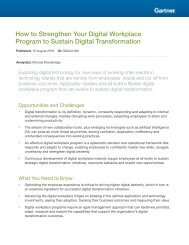The_Future_of_Employment
You also want an ePaper? Increase the reach of your titles
YUMPU automatically turns print PDFs into web optimized ePapers that Google loves.
<strong>of</strong> mechanisation, with dictaphones, calculators, mimeo machines, address machines,<br />
and the predecessor <strong>of</strong> the computer – the keypunch (Beniger, 1986;<br />
Cortada, 2000). Importantly, these <strong>of</strong>fice machines reduced the cost <strong>of</strong> information<br />
processing tasks and increased the demand for the complementary factor –<br />
i.e. educated <strong>of</strong>fice workers. Yet the increased supply <strong>of</strong> educated <strong>of</strong>fice workers,<br />
following the high school movement, was associated with a sharp decline<br />
in the wage premium <strong>of</strong> clerking occupations relative to production workers<br />
(Goldin and Katz, 1995). This was, however, not the result <strong>of</strong> deskilling technological<br />
change. Clerking workers were indeed relatively educated. Rather, it<br />
was the result <strong>of</strong> the supply <strong>of</strong> educated workers outpacing the demand for their<br />
skills, leading educational wage differentials to compress.<br />
While educational wage differentials in the US narrowed from 1915 to 1980<br />
(Goldin and Katz, 2009), both educational wage differentials and overall wage<br />
inequality have increased sharply since the 1980s in a number <strong>of</strong> countries<br />
(Krueger, 1993; Murphy, et al., 1998; Atkinson, 2008; Goldin and Katz, 2009).<br />
Although there are clearly several variables at work, consensus is broad that<br />
this can be ascribed to an acceleration in capital-skill complementarity, driven<br />
by the adoption <strong>of</strong> computers and information technology (Krueger, 1993; Autor,<br />
et al., 1998; Bresnahan, et al., 2002). What is commonly referred to as the<br />
Computer Revolution began with the first commercial uses <strong>of</strong> computers around<br />
1960 and continued through the development <strong>of</strong> the Internet and e-commerce<br />
in the 1990s. As the cost per computation declined at an annual average <strong>of</strong> 37<br />
percent between 1945 and 1980 (Nordhaus, 2007), telephone operators were<br />
made redundant, the first industrial robot was introduced by General Motors<br />
in the 1960s, and in the 1970s airline reservations systems led the way in selfservice<br />
technology (Gordon, 2012). During the 1980s and 1990s, computing<br />
costs declined even more rapidly, on average by 64 percent per year, accompanied<br />
by a surge in computational power (Nordhaus, 2007). 13 At the same time,<br />
bar-code scanners and cash machines were spreading across the retail and financial<br />
industries, and the first personal computers were introduced in the early<br />
1980s, with their word processing and spreadsheet functions eliminating copy<br />
typist occupations and allowing repetitive calculations to be automated (Gordon,<br />
2012). This substitution for labour marks a further important reversal.<br />
13 Computer power even increased 18 percent faster on annual basis than predicted by<br />
Moore’s Law, implying a doubling every two years (Nordhaus, 2007).<br />
11





